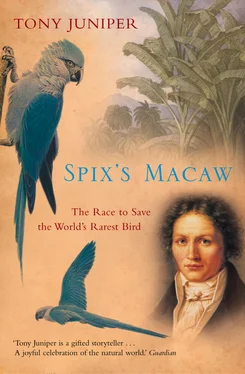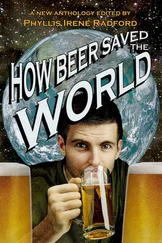Despite the dangers, it was with great enthusiasm and apparently little thought for their impending discomfort that on 9 December 1817 Spix and Martius set out from the coast for the interior of Brazil. Although misgivings about their venture were expressed by Brazilian friends, the Bavarians happily set off with a team that included a guide hired in Rio de Janeiro, a mule man, a drover, a ‘newly bought Negro slave’ and eight mules, two for riding and six more for their bags and equipment.
They met several early setbacks. In addition to being assailed by a huge variety of fleas, ticks, flies, mosquitoes and other biting and disease-carrying insects, the scientists’ guide decided to go his own way. He left one night, when everyone was asleep, never to be seen again. He had taken most of their valuables. Spix and Martius were forced to recruit new help and to replace stolen equipment before they resumed their journey through the recently colonised landscape.
The countryside was sparsely settled but in some places the clearance of the native vegetation was already well under way. They wrote that ‘From Ytú we advanced N.W. by the side of beautiful thick woods, and enjoyed a delightful view of the valley of the Tieté, which is now entirely cleared of the forests, and planted with sugar cane, beans, maize and so on.’ It was in this area that their slave decided to follow the earlier example of the guide and make an unscheduled departure himself.
According to Spix and Martius the slave ‘did not know how to appreciate our kind treatment of him, and embraced the first favourable opportunity to abscond’. He was, however, brought back to them next day by professional runaway slave hunters the men had engaged locally. The naturalists wrote ‘we followed the advice of our host, treating him, according to the custom of this place, very kindly … giving him a full glass of brandy.’
In addition to the departure of their staff, flooded roads, swollen streams and cold mist dogged their progress. But despite the difficult conditions the two scientists earnestly persisted with their scientific work. ‘If in the evening we at length met with an open shed, or dilapidated hut, we had to spend the greater part of the night in drying our wet clothes, in taking our collections out of the chests and again exposing them to the air.’ On drier days they would spend twilight and hours after dark ‘writing notes in the journals, in preparing, drying and packing our collections’. Despite the hardships, they recalled how ‘This simple mode of life had its peculiar charms.’
To early Portuguese visitors, Brazil was known as the land of parrots. Spix and Martius came across plenty of them as well. In August 1818, in the region of Januária in Minas Gerais in the upper reaches of the river São Francisco, the Bavarian travellers happened upon what were almost certainly Hyacinth Macaws in a ‘magnificent forest of buriti palms’. The large cobalt-blue birds circled over the travellers in pairs with their croaking calls echoing in the still and peaceful surroundings. A few days later, Martius and Spix briefly split up. Martius set off into the dry semi-arid forests that fringe the river São Francisco. Here he found forests of indaja palms, which, because of the much drier conditions, were the first palm groves that they had found ‘where we dared to roam around with dry feet and safe from giant snakes and alligators’.
Martius observed with fascination how the local Hyacinth Macaws greedily ate the palm fruits. ‘The large nuts of these palms with their very fine rich oil make them the favourite trees of the large blue macaws which often flew off in pairs above us. As beautiful as this bird’s plumage is, its hoarse penetrating call assaults even the most insensitive of ears and if it had been known in ancient times, would have been regarded an ominous bird of deepest foreboding.’
For the Hyacinth Macaw, the arrival of the Europeans was indeed a compelling omen of ill fortune. Martius’s party themselves captured some of the birds. He later remarked, ‘the small menagerie of these quarrelsome birds, which we took with us chained to the roof of a few mule loading platforms, played a special role in that their continuous noise, which could be heard from afar, indicated the location of the caravan, which we usually left far behind in our forays to investigate the region.’
Martius and Spix most likely knew about the Hyacinth Macaw before they arrived in Brazil. That species had by then been described to science by a British ornithologist, Dr John Latham. He had spent years cataloguing museum collections, including the birds collected during Cook’s eighteenth-century voyages in the Pacific. In 1790 he was the first to grant a scientific name to the giant blue parrots. But the two Bavarians were the first to note the relationship between these magnificent blue birds and different kinds of palms, upon the fruits of which they dined.
By November Spix and Martius reached the coast of eastern Brazil and the town of Salvador in Bahia. The grinding travel schedule had taken its toll, so they rested there until mid-February 1819 to recover their strength. They then set out north through the harsh drought-prone north east of Brazil. They suffered extreme hardships, notably lack of water, and often travelled in uninhabited country. By May they had reached the banks of the river São Francisco at Juàzeiro.
Along the north and south shores of the great river they found the thorny caatinga woodlands. This dry country stretched in all directions to the horizon and beyond. It was sparsely settled and mainly used for sheep and cattle pasture. In this strange dry land Spix spent some time collecting birds.
Among other things, it was here that he shot a magnificent long-tailed blue parrot for their collection. The bird was taken from some curious woodlands found along the side of creeks seen in that part of the caatinga. The specimen of the parrot was tagged and brief notes were made about it. Spix recorded that ‘it lives in flocks, although very rare, near Juàzeiro in the region bordering the São Francisco, [and is] notable for its thin voice.’ Spix didn’t realise that he had just taken the very first specimen of a bird that would one day symbolise how human greed and ignorance were wiping countless life forms from the record of creation.
From Juàzeiro the pair travelled through the parched woodlands north along the river Caninde to Oeiras in Piauí, close to the modern city of Floriano. Martius wrote ‘The caatingas mostly consisted of sparse bushes and in the lowland areas, where there was much more water, the carnauva palms formed stately forests, the sight of which was as strange as it was delightful. Blue macaws, which live in the dense tops of these palms, flew up screeching above us.’ It seemed that the travellers had happened on more Hyacinth Macaws or perhaps their rarer and smaller cousins, Lear’s Macaws – one of the ‘four blues’ exhibited in Berlin in 1900 (see chapter 4).
By the end of 1819 Spix and Martius had worked their way inland about 3,000 kilometres further west, mainly by river, penetrating deep inside the seemingly limitless rainforests of the Amazon basin. From here they split up and travelled further into the vast interior of South America. They finally arrived nearly 3,000 kilometres further downstream at the port of Belém in Pará at the mouth of Amazon on 16 April 1820. Their collection of specimens and live animals was loaded aboard the Nova Amazonia and they set sail for Lisbon. They travelled through Spain and France to arrive back in Munich on 10 December 1820, nearly four years after they had left.
Throughout their extensive travels Spix and Martius made careful observations and notes on the wildlife they encountered. They were also careful to note details of the local economy in the places they visited, especially mining and agriculture, and in so doing they painted a picture for those who would follow of investment, trading and other commercial opportunities. It is no coincidence that the greatest concentration of German industry anywhere in the world today is still in the Brazilian super metropolis of São Paulo. Certainly this fact is linked to the historical relationships between the two countries and the commercially significant information provided by early travellers. Thus commenced centuries of encroachment into the world’s biologically richest and remotest places – a process that continues today, only now hugely accelerated and more often with the aid of remote sensing from spacecraft than with the assistance of mules.
Читать дальше












